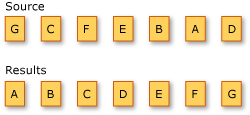Sorting Data (Visual Basic)
A sorting operation orders the elements of a sequence based on one or more attributes. The first sort criterion performs a primary sort on the elements. By specifying a second sort criterion, you can sort the elements within each primary sort group.
The following illustration shows the results of an alphabetical sort operation on a sequence of characters.

The standard query operator methods that sort data are listed in the following section.
Methods
| Method Name | Description | Visual Basic Query Expression Syntax | More Information |
|---|---|---|---|
| OrderBy | Sorts values in ascending order. | Order By |
Enumerable.OrderBy Queryable.OrderBy |
| OrderByDescending | Sorts values in descending order. | Order By … Descending |
Enumerable.OrderByDescending Queryable.OrderByDescending |
| ThenBy | Performs a secondary sort in ascending order. | Order By …, … |
Enumerable.ThenBy Queryable.ThenBy |
| ThenByDescending | Performs a secondary sort in descending order. | Order By …, … Descending |
Enumerable.ThenByDescending Queryable.ThenByDescending |
| Reverse | Reverses the order of the elements in a collection. | Not applicable. | Enumerable.Reverse Queryable.Reverse |
Query Expression Syntax Examples
Primary Sort Examples
Primary Ascending Sort
The following example demonstrates how to use the Order By clause in a LINQ query to sort the strings in an array by string length, in ascending order.
Dim words = {"the", "quick", "brown", "fox", "jumps"}
Dim sortQuery = From word In words
Order By word.Length
Select word
Dim sb As New System.Text.StringBuilder()
For Each str As String In sortQuery
sb.AppendLine(str)
Next
' Display the results.
MsgBox(sb.ToString())
' This code produces the following output:
' the
' fox
' quick
' brown
' jumps
Primary Descending Sort
The next example demonstrates how to use the Order By Descending clause in a LINQ query to sort the strings by their first letter, in descending order.
Dim words = {"the", "quick", "brown", "fox", "jumps"}
Dim sortQuery = From word In words
Order By word.Substring(0, 1) Descending
Select word
Dim sb As New System.Text.StringBuilder()
For Each str As String In sortQuery
sb.AppendLine(str)
Next
' Display the results.
MsgBox(sb.ToString())
' This code produces the following output:
' the
' quick
' jumps
' fox
' brown
Secondary Sort Examples
Secondary Ascending Sort
The following example demonstrates how to use the Order By clause in a LINQ query to perform a primary and secondary sort of the strings in an array. The strings are sorted primarily by length and secondarily by the first letter of the string, both in ascending order.
Dim words = {"the", "quick", "brown", "fox", "jumps"}
Dim sortQuery = From word In words
Order By word.Length, word.Substring(0, 1)
Select word
Dim sb As New System.Text.StringBuilder()
For Each str As String In sortQuery
sb.AppendLine(str)
Next
' Display the results.
MsgBox(sb.ToString())
' This code produces the following output:
' fox
' the
' brown
' jumps
' quick
Secondary Descending Sort
The next example demonstrates how to use the Order By Descending clause in a LINQ query to perform a primary sort, in ascending order, and a secondary sort, in descending order. The strings are sorted primarily by length and secondarily by the first letter of the string.
Dim words = {"the", "quick", "brown", "fox", "jumps"}
Dim sortQuery = From word In words
Order By word.Length, word.Substring(0, 1) Descending
Select word
Dim sb As New System.Text.StringBuilder()
For Each str As String In sortQuery
sb.AppendLine(str)
Next
' Display the results.
MsgBox(sb.ToString())
' This code produces the following output:
' fox
' the
' quick
' jumps
' brown
See also
Feedback
Coming soon: Throughout 2024 we will be phasing out GitHub Issues as the feedback mechanism for content and replacing it with a new feedback system. For more information see: https://aka.ms/ContentUserFeedback.
Submit and view feedback for
